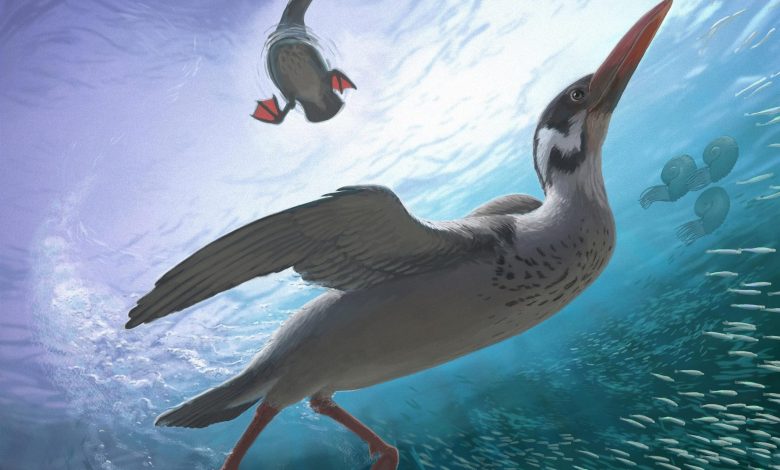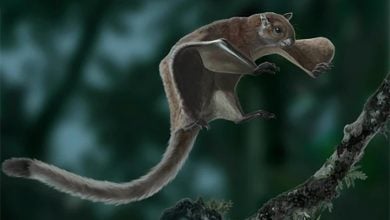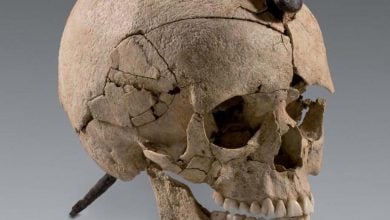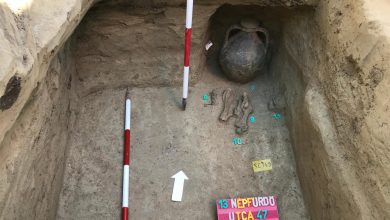“Aneh dan indah” – fosil kuno menantang apa yang kami pikir kami ketahui tentang evolusi burung


Yang baru dipelajari Vegavis Iaai Tengkorak dari Antartika menegaskan bahwa garis keturunan burung modern, seperti bebek dan angsa, berkembang bersama dinosaurus non-Avian. Studi ini mendukung penempatan Vegavis dalam kelompok Anseriformes meskipun bentuk paruh yang tidak terduga, menyoroti keragaman burung kuno.
Studi baru di Alam Menjelaskan tengkorak burung fosil yang hampir lengkap dan utuh dari Antartika, memberikan wawasan tentang evolusi awal burung modern dan keragaman burung di akhir zaman dinosaurus.
Tengkorak itu milik Vegavis Iaaiburung seperti bebek yang punah yang hidup pada akhir[{” attribute=”” tabindex=”0″ role=”link”>Cretaceous, just before non-avian dinosaurs went extinct. It is one of the few known three-dimensional bird skulls from the Cretaceous—a 79-million-year geological period and the final era when non-avian dinosaurs roamed the Earth.
Vegavis is among the best-known bird species from this era. There are multiple fossils of this bird, including the oldest known fossil bird vocal organ. But research on the new skull — and the shape of the brain inside it — isn’t only helping scientists learn more about this particular extinct bird species, but the origins and evolution of birds that are still living today.

“There are very few brains to illuminate this phase of avian evolution,” said Chris Torres, an assistant professor at the University of the Pacific, who led the study.
Torres conducted the research as a National Science Foundation postdoctoral fellow at Ohio University, and began it as a graduate student at The University of Texas at Austin, working with Julia Clarke, a professor at the UT Jackson School of Geosciences.
Decades of Research on Vegavis
The new study is the latest in a long list of Vegavis discoveries by Clarke. She and colleagues identified and named the species in 2005, working with a specimen that was discovered on Antarctica’s Vega Island in 1992. The specimen was the first example of a direct relative of modern birds from the Late Cretaceous — and served as evidence that living bird relatives and their non-avian dinosaur cousins co-existed. In 2016, Clarke and other collaborators discovered a fossilized syrinx — a bird vocal organ — in a different Vegavis specimen. And in 2011, she was part of the fossil finding mission to Antarctica where the skull was discovered by study co-author and geologist Eric Roberts, a professor at the Colorado School of Mines.
When Clarke identified Vegavis, she determined that it was closely related to modern ducks and geese and could be categorized in an evolutionary group called Anseriformes that encompasses both types of birds. But since then, other researchers have suggested that Vegavis is much more distantly related to most bird lineages today.

“Few birds are as likely to start as many arguments among paleontologists as Vegavis,” said Torres.
But answering the question of where Vegavis lands on the tree of life isn’t just a technical point of discussion between paleontologists. It can help answer a big open question in bird evolution: Did it take the demise of non-avian dinosaurs for modern birds to diversify into the many lineages still with us today? Or was this diversification already well underway during the Age of Dinosaurs? Also, what role, if any, did the asteroid impact that ended the Cretaceous have on modern birds and their diversification?

Surprising Anatomical Features
Thanks to this new study, the researchers have confidently found a taxonomic home for Vegavis. Its broad collection of anatomical traits keeps it in the Anseriformes group, as Clarke previously hypothesized. This outcome suggests that the earliest diverging modern bird lineages were evolving alongside non-avian dinosaurs.
Its placement came as a bit of a surprise, according to the researchers. That’s because the Vegavis skull has some decidedly un-ducklike features. Most notably, a long, spear-shaped beak.
“I think it gave some people pause,” Clarke said. “They expected [the skull] menjadi lebih banyak bebek atau seperti angsa. “
Clarke mencatat bahwa bebek dan angsa saat ini hanyalah sedikit pilihan burung anseriform yang telah hidup dari waktu ke waktu. Ada contoh-contoh dari catatan fosil burung seperti bebek yang memiliki gaya hidup yang mirip dengan bangau dan flamingo saat ini. Vegavis Dan paruhnya yang khas menggarisbawahi keragaman burung seperti bebek yang pernah berjalan di bumi.
“Di masa lalu, mereka aneh dan luar biasa,” kata Clarke. “Kami memiliki jangkauan besar ini [of now-extinct anseriform birds] Dan Vegavis konsisten dengan itu. ”
Studi ini juga menyoroti nilai meneliti secara mendalam satu spesies. Clarke dan rekan -rekannya telah menghabiskan beberapa dekade menganalisis Vegavis Fosil dari Antartika. Tetapi apa yang telah mereka temukan adalah memiliki efek riak di seluruh pohon evolusi, kata rekan penulis Patrick O'Connor, seorang profesor di Universitas Ohio dan Direktur Ilmu Bumi dan Luar Angkasa di Museum Alam & Sains Denver.
“Fosil baru ini mengungkapkan bahwa Antartika memiliki banyak hal untuk memberi tahu kami tentang tahap paling awal evolusi burung modern,” katanya.
Fosil hewan dan tumbuhan sejak saat ini di Antartika sangat jarang, yang mengarah ke lebih banyak pertanyaan tentang sifat lingkungan di mana burung dan bentuk kehidupan lainnya berasal dan beragam.
“Sesuatu yang sangat berbeda tampaknya telah terjadi di jauh dari belahan bumi selatan, khususnya di Antartika,” kata O'Connor. “Ini membutuhkan pandangan yang lebih dekat ke dalam catatan fosil dan lingkungan yang berubah dari wilayah ini melalui waktu.”
Jelajahi lebih lanjut: Misteri evolusioner 69 juta tahun: para ilmuwan menemukan burung modern tertua
Referensi: “Tengkorak Burung Antartika Kapur menjelaskan keanekaragaman ekologis unggas awal” oleh Christopher R. Torres, Julia A. Clarke, Joseph R. Groenke, Matthew C. Lamanna, Ross de Macphee, Grace M. Musser, Eric M. Roberts dan Patrick M. O'Connor, 5 Februari 2025, Alam.
Doi: 10.1038/s41586-024-08390-0
Rekan penulis tambahan penelitian ini adalah Joseph Groenke dari Ohio University, Matthew Lamanna dari Carnegie Museum of Natural History, Ross Macphee dari American Museum of Natural History, dan Grace Musser dari UT Austin dan Museum Nasional Sejarah Alam Smithsonian.
Penelitian ini didanai oleh National Science Foundation.




